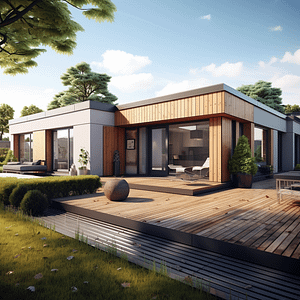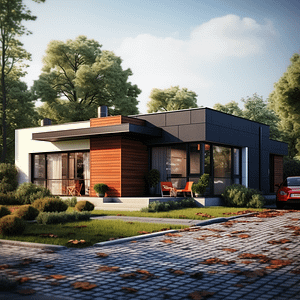Interior finishing
ShellBau - How to correctly perform all interior finishing in sequence
Interior finishing
In the company “Shellbau,” we typically use gypsum plasterboard panels for interior wall finishing. These panels can be installed longitudinally, transversely (vertically, horizontally), or, in the case of a double-layer cladding, in both ways.
Vertical installation. Panel width - 1,200 mm, distance between stud axes - 600 mm (profiles are mounted on the Shellbau butt-joint beams). Horizontal installation of the lower layer and vertical installation of the upper layer. Panel widths - 625 mm (lower) and 1,200 mm (upper), distance between stud axes - 600 mm. When installing a multi-layer panel covering, the joints (both horizontal and vertical) of each layer must be staggered. Partition installation in frame houses. If the distance between walls exceeds 6,000 mm, partition walls are constructed using frame-specific partition panels. For other rooms, the following procedure is used with a standard drywall partition system.
Montavimo eiga
Marking the location of future partitions.
A sealing tape is glued to the back of the metal horizontal profile (UW) intended for partitions, which seals minor substrate irregularities (up to 2 mm; if irregularities are larger, sealing compound is used) and prevents sound from spreading around the perimeter and between structures.
Horizontal metal profiles are attached to the floor and ceiling.
In these profiles, vertical profile positions are marked every 60 cm (steps).
Studs are installed and leveled, connecting the structure with special connectors, securing the top and bottom of the studs to the horizontal profiles
Mineral wool is placed in the installed struts. The cotton blankets must adhere to the horizontal profiles, so their width must be 1 cm greater than the step of the vertical struts.
Drywall panels are cut according to the height of the wall.
The first layer of plasterboard is installed. The first layer is fixed with self-tapping screws TN or XTN every 75 cm. The distance of self-tapping screws from the edge of the edge covered with cardboard must be at least 10 mm, from the cut edge - at least 15 mm. Self-tapping screws are selected according to the thickness of the plate, they must cross the profile metal at least ≥ 10 mm.
The panels can be fixed both vertically and horizontally. If the panels will be installed vertically, it is recommended to use them over the entire height of the room, i.e. i.e. without horizontal joints.
If two or three layers of panels are installed, all of them are fixed to the metal frame with staples.
When preparing a wall or partition for finishing ceramic tiles, the thickness of plasterboard panels must be at least 12.5 mm. If a single-layer structure will be installed, the step of the struts must not exceed 400 mm.
An adhesive separation tape is glued around the perimeter.
Before plastering, all sawn seams are covered with a deep primer.
Gypsum putty is used to seal the joints of the panels.
Reinforcing tape is not required for the first layer. Perimeter seams are filled with putty.
The second layer of plasterboard panels is installed, the seams of which cannot coincide with the seams of the first layer. The second layer is fixed with self-tapping screws every 25 cm.
It is best to use paper reinforcing tapes to reinforce the seams of the second layer, then putty.
The floor
Before installing the floor covering in wet areas, it is necessary to cover the panels of the company “Shellbau” with a waterproofing covering layer. The waterproofing coating is used to install elastic composite waterproofing on standard floor surfaces.
- The waterproofing membrane is laid on the base, leaving a gap of 10-15 cm around the perimeter of the room.
- The membrane is glued to the base with glue.
- The membrane is connected with a special adhesive tape.
The gaps around the perimeter of the room are sealed with waterproofing strips.
After covering the floor with a waterproofing material, you can lay the selected finishing layer, for example, tiles, various wood coverings, polyvinyl chloride covering or linoleum.
If you want to strengthen the waterproofing, you can use reinforcing tape. The reinforcing tape is laid on the waterproofing membrane to ensure sufficient strength and durability.
If the base can be affected by moisture from both sides, a special waterproofing membrane must be used, which has two layers. The first layer is sticky and works well as a base for the second layer. The second layer is water and moisture resistant.
Preparation
- The floor must be clean, dry and level.
- If the base is uneven, it needs to be leveled.
- If the base is old or damaged, it needs to be strengthened.
- If the base is wet, it needs to be dried.



